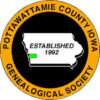Information courtesy of the Douglas-Sarpy Counties [NE] Mormon Trails Assoc.
Indian Country
When the Latter-day Saints reached the Missouri River June 14, 1846, they had reached the organized territorial limits of the United States. What lay west of the Missouri had been designated by Congress as “Indian Country.” American law there was applied by virtue of treaties with the Indians. Some 2,250 Pottawattomie/Ottawa/Chippewa Indians lived in at least five widely scattered villages in southwest Iowa. Approximately 1,300 Omaha Indians lived atop an oak-knolled hill about three miles west of the tiny village of Bellevue, Nebraska. Half of 930 Oto/Missouri Indians lived in a village eight miles southwest of Bellevue. The other half lived in at least three villages south of the Platte River. The Pottawattomies sympathized with the Mormons’ exodus because they, too, had been forced from their homes in more eastern states and they had been befriended by the Mormons before the Mormons were expelled from Nauvoo, Illinois. Miraculously, chiefs of the Pottawattomie/Ottawa/Chippewa had agreed in Washington, DC, in May 1846 to sell their lands in southwest Iowa and move to northeast Kansas the following year. This paved the way for Iowa to become a state on December 28, 1846. Though the Oto/Missouri and the Omaha Indians did not sell their lands in eastern Nebraska until 1854, the Omaha Indians did agree to let the Mormons stay west of the Missouri River at least two years, in preparation for their move on to the Great Salt Lake Valley.
Grand Encampment
The Mormons’ main staging area at the Missouri River was a camp called Grand Encampment. This was located near where the Iowa School for the Deaf is now located, south of Council Bluffs, and extended nine miles to the east. Because there was not enough grass, wood, and water to support 10,000 to 15,000 people, 3,000 wagons, 30,000 cattle, immense flocks of sheep and great numbers of horses and mules, the Mormons fanned out on both sides of the river (mostly on the Iowa side) to settle small communities. Historians have identified nearly 80 communities established by the Mormons from 1846 to 1852. The two largest were Winter Quarters on the Nebraska Indian Territory side and Miller’s Hollow (later named Kanesville) on the Iowa side.
Miller’s Hollow
One of these eighty communities, Miller’s Hollow, was established about the same time as Grand Encampment. This small community was to later become much larger and have several name changes. In 1848, those at Winter Quarters who had not gone west abandoned that town and went back across the river to Miller’s Hollow and named it Kane. A very short time later, the name was again changed to Kanesville. In 1853, after most of the remaining Mormons went to the Salt Lake Valley at the request of Church leaders. Those who took over Kanesville renamed the very active frontier town Council Bluffs, capitalizing on the name of the area on both sides of the Missouri River that had been so named by fur traders and trappers even before 1846.
Where is Council Bluff?
It is believed Lewis and Clark met with the Indians near where present-day Fort Calhoun, Nebraska, is now located. This meeting location was called Council Bluff. Gradually the name Council Bluff(S) was used to describe the entire area on both sides of the river by traders and explorers. The town, which was previously called Kanesville, was renamed Council Bluffs in 1853.
